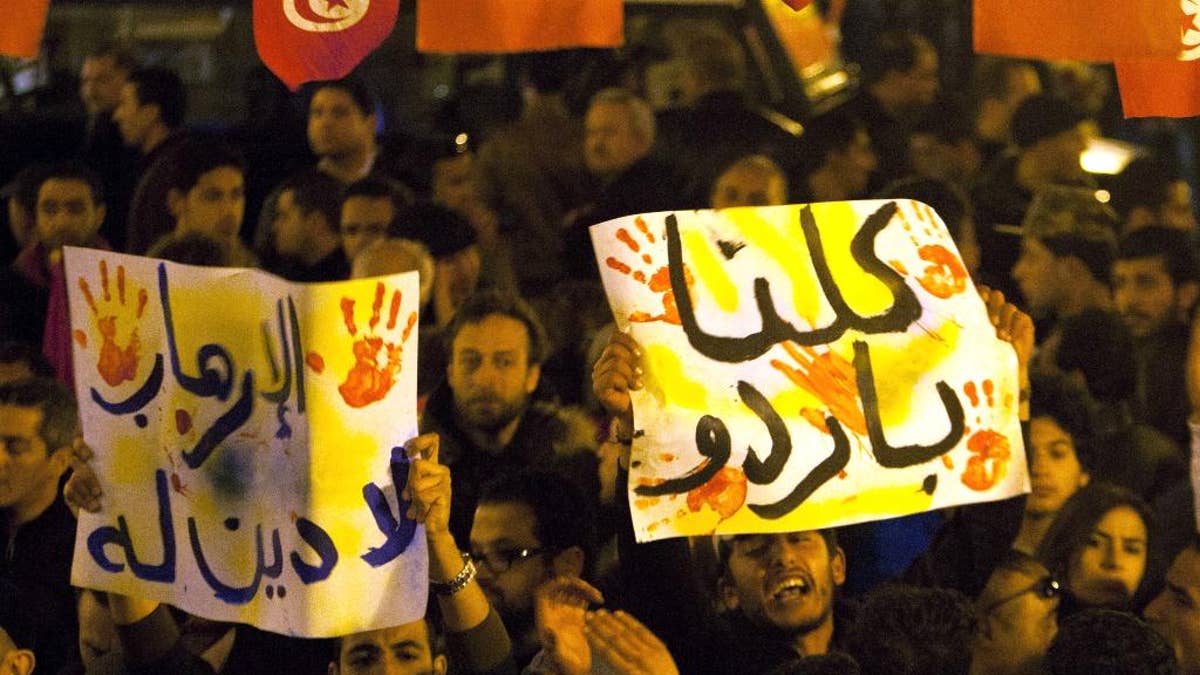
Tunisians gather at Habib Bourguiba avenue to show solidarity with the victims of the attack at a museum in Tunis, Wednesday, March 18, 2015. Gunmen opened fire Wednesday at a major museum in Tunis, killing scores of people, mostly foreigners, in one of the worst attacks in this struggling North African democracy that depends heavily on tourism. Placard reads, "no to terrorists". (AP Photo/Adel Mhamdi) (The Associated Press)
RABAT, Morocco – The attack on Tunisia's national museum and the nearby parliament on Wednesday could have come from the radical militants who have been fighting the Tunisian government since the 2011 revolution that overthrew the country's long-ruling secular dictator — though this is the first time foreigners and civilians have been targeted on such a scale. Here's a look at the possible perpetrators behind the attack.
___
DIFFUSE MILITANTS
It is likely the perpetrators did not come from any particular established terror group, but are instead part of the large mass of disaffected young people in the country, some of whom fought with extremists groups in Syria and have been inspired by the rhetoric of the radical Islamic State group.
Years of uneven economic development, followed by a post-revolutionary downturn, have left a deep reservoir of disaffected and unemployed young people. Many have left for Syria — or even easier, neighboring Libya — to train and fight with radical groups.
The government says 500 Tunisians have returned from Syria, and one parliamentarian told The Associated Press after the attack that there could be as many as 2,000 radical sympathizers in the country.
Weapons smuggled from Libya or even further south from Mali have been plentiful in the south of the country and in the past year, a security crackdown has resulted in nearly a dozen firefights outside militant homes.
A tweet from a Twitter account that regularly posted radical material about Tunisia and Libya before it was shut down Thursday held the museum attack up as an example of the simple, low-cost operation that Muslims should be undertaking in their own countries.
___
SALAFIS TURNED JIHADIS
In the wake of the revolution, men with beards were suddenly everywhere in Tunisia as the fall of the secular dictator emboldened extremely pious Muslims known as Salafis to begin preaching across the country. The largest group was known as Ansar al-Shariah movement and in a bold showing of strength in 2012, some 4,000 group members of the movement gathered in Kairouan, Tunisia, one of Islam's most revered cities.
The group clashed with the state and in September 2012 mounted an attack on the U.S. embassy, prompting a crackdown on the group. Its leader, Seifallah Ben Hassine, fled to Libya — where authorities have said the group has training camps — with many supporters. His lieutenant, Ahmed Rouissi, was recently killed in fighting in Libya.
The moderate Islamist government launched a widespread crackdown on Ansar al-Shariah and other groups in 2013, prompting al-Qaida to say Tunisia was no longer just a recruiting ground but a site for struggle as well.
The organization has since gone underground and its diffuse networks of support are believed to be behind isolated attacks over the years, including failed suicide bombings in October 2013 at Tunisian tourist sites.
___
MOUNTAIN MEN
In 2013, a band of fighters called the Oqba Ibn Nafaa brigade, named after the 7th-century Arab conqueror of Tunisia, pledged allegiance to al-Qaida's North African branch. It is based in the mountainous region in the southwest near the Algerian border and has stubbornly resisted army efforts to dislodge it.
The group has been linked to the assassinations of two opposition politicians in 2013 as well as clashes and ambushes with security forces that have killed dozens.
The group survives in part due to the dissatisfaction of the residents of these poor regions with the central government. While usually estimated to be just a few hundred fighters, it is believed to have links with cross border smugglers as well as the veteran Algerian jihadists across the border.
